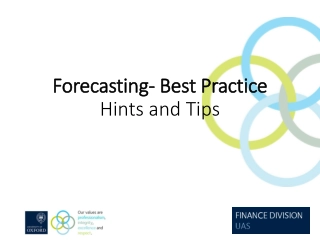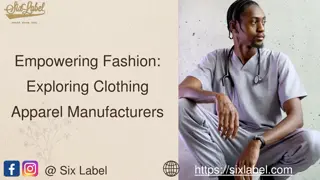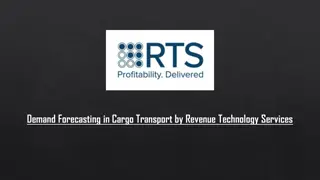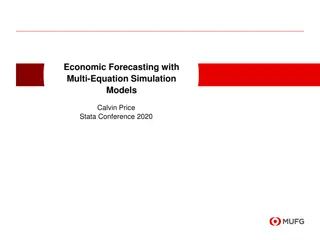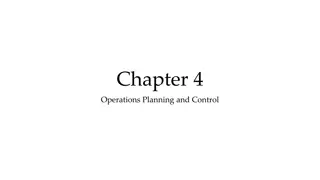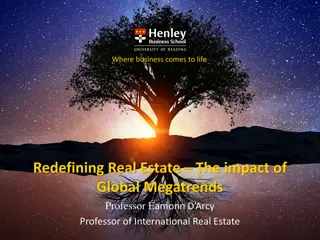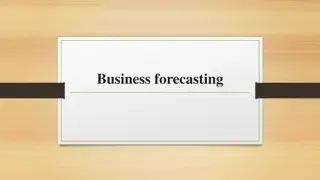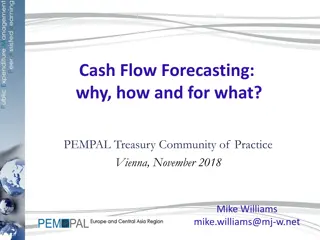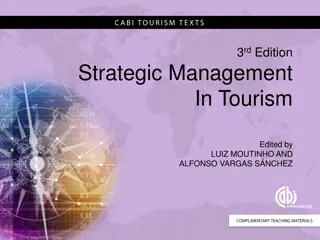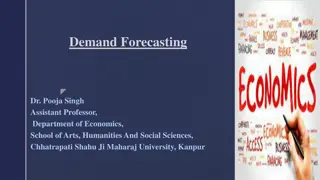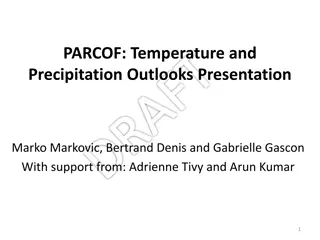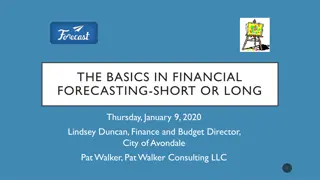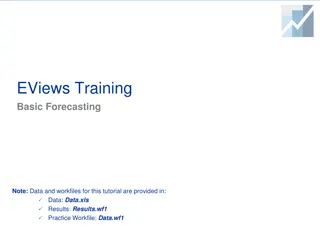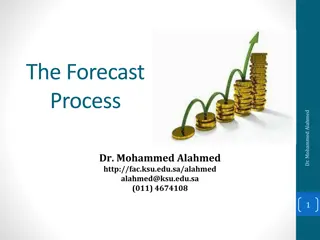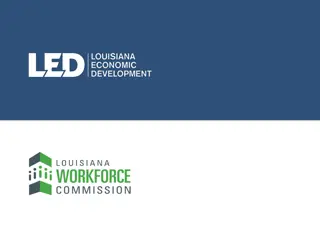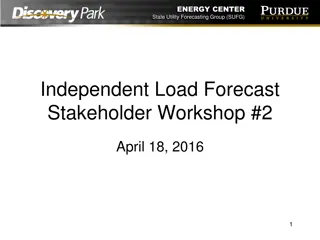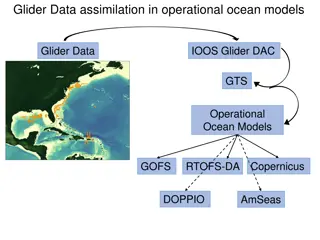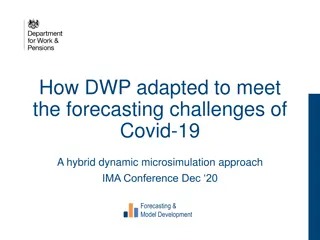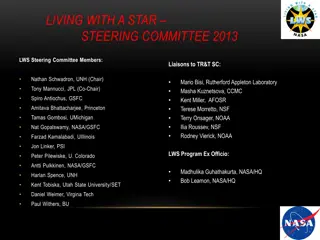Exploring Modern Forecasting Methods in Fashion and Megatrends
Delve into the world of fashion forecasting and megatrends, understanding the significance of long-term forecasting in decision-making for the textile and apparel industry. Discover the methodology, evolution, and key concepts of trendspotting, style eruptions, and the process of long-term forecasting. Learn how lifestyle trends differ from style trends and how forecasters anticipate the future by linking breakthroughs to demographic trends.
Download Presentation

Please find below an Image/Link to download the presentation.
The content on the website is provided AS IS for your information and personal use only. It may not be sold, licensed, or shared on other websites without obtaining consent from the author. Download presentation by click this link. If you encounter any issues during the download, it is possible that the publisher has removed the file from their server.
E N D
Presentation Transcript
Modern Forecasting Methods Fashion Forecasting Prof. Guidato
Modern Forecasting Methods Key concepts : Identify the characteristics of long-term forecasting Explain how long-term forecasting supports the decision making of executive in the textile and apparel industry Understand the methodology and evolution of long-term forecasting Review current forecasting authors and experts
Navigating Change Lifestyle trends ,differently from style trends that move very quickly trough culture ,aided by media and internet, recognize consumer priorities and influence decisions in every aspect of life. Working on long timeline-5 y,10 or even longer-forecasters anticipate the future by linking breakthroughs in science ,technology, and medicine to the likely course of demographic trends. Most large business utilize long-term forecasters as consultants or subscribe to trend reports by their companies . https://www.youtube.com/watch?v=nNWFn1rcNG8 https://www.youtube.com/watch?v=9IouItawTOE
Trendspotting and Megatrends In 1982 John Naisbitt published his book Megatrends that was the first trendsetting book to become a best-seller .Naisbitt identified ten megatrends including : The move toward an information-based economy; The dual compensation of high-tech and high-touch products ; The shift to a global economy; The shift away form hierarchal structures in favor or informal networks; The shift from an either/or to a multiple-option society.
The process of long-term forecasting Forecasters and futurist have a four elements approach to arrive at long-term forecasts : The time frame for predictions-5,10 years or more The techniques used to capturing signals and make the forecasts; The methods used to interpret signals and make the forecasts; The range if the forecasters ,whether general or restricted to certain countries or economic systems, particular cohorts, or specific industries
Style Eruptions Henrik Vejlgaard published Anatomy of a trend ( 2008) and Style Eruptions (2013).V. estimates the approximate duration for how long it takes for a trend to go from the trendsetters to the mainstream for the five following product categories: Cosmetic: 1-2 years Clothes: 2-3 years Accessories : 2-3 years Home design: 5-7 years Sports equipment : 6-8 years
Contagious In his book 'Contagious: why things catch on '(2013) ,Jonah Berger addresses why people talk about certain products and ideas more than others ,and what makes online content go viral.Berger shares 6 principles of contagiousness that can encourage the diffusion of a trend . These principles coded as STEPPS are : Social currency-Share thing that make us look good to others Triggers-Top of mid ,tip of tongue .Triggers are the stimuli that prompt people to think about related things Emotion-When we care, we share. Public-Built to show, built to grow.Making things more observable make them easier to imitate. Practical value-News you can use.If a product can demonstrably save time, improve healthier save money ,it isomer likely to be shared. Stories-Information travels under the guise of idle chatter.*Burberry art of trench https://vimeo.com/192629284 https://www.youtube.com/watch?v=FN4eDk1pq6U https://www.youtube.com/watch?v=HfSs_hOAkzY
The next big thing Author William Higham defines trends initiators as those things a consumer reacts to' in his book' The next big thing'( 2009).Trends initiators can be segmented into 4 categories under the acronym of PEST. Political Initiators Economical Initiators Sociocultural Initiators Technological Initiators http://test.wsta.co.uk/events/wsta-annual-conference?id=783
Trends typologies Behavioral vs Attitudinal Behavioral trends can have a direct impact on sales-like for example sales of fast fashion have had a negative impact on designer clothing sales. Attitudinal trends do not have a direct trend on sales, but they are important to identify in order to craft a marketing strategy that appeals consumers preferences. Micro vs Macro Microtrends affects a small number of consumers ,they are larger then fads and they are helpful to predict future trends because they can be indicators of larger trends. Macrotrends are themes powerful trends as they represent shifts that influence a wide range of sectors ,markets, and demographics. International vs National International trends spread between countries that share similar socioeconomic traits ;if a trends spreads trough several nations it can be called a global trend.National trends spread only in one nation because each country has its own identity .Much like micro trends ,national trends are useful to predict future global trends.
Forecasting reports Lidewji Edelkoort combines articles about cities, artists , and movements that will impact our future .In one recent article ,connections are drawn between an arts who converts traditional caravans into guest houses ,how smartphones and tablets have enabled us to work anywhere ,and the fashion inspiration of the Bedouin people all work together to form the basis of a rising trend the site class Nomadism . http://www.edelkoort.com/ https://www.youtube.com/watch?v=dI64N0dyh7k Trend forecaster Nelly Rodi in her online publication Nelly Rodi Lab breaks research into several sections, including Lifestyle,Fashion ,Beauty ,Inspiration, Color, Talents Communications , and Retail. Fashion forecasting resources such as these make it easy to stay informed about how industry professionals find connections between seemingly unrated events and sources to define the trends that will ultimately influence our future behavior.
Long-term forecasting Long-term forecasts provide: Insights that are valuable in evaluating current business practices ; Indications that a business needs to reposition the product or the way relating to customers; A backdrop for understanding and evaluating short- term forecasting
Long-term forecasting Trend-spotting depends on being able to filers the trends from the spread of information.The forecaster is looking for: Shots in demographics that can restructure society; Changes in industry and market structure; Difference in consumer interests, values, and motivation; Breakthroughs in technology and science; Changes in the economic picture; Alteration in political, cultural, and economic alliance between countries.
Research Strategy 1:Media Scan Scanning media for clues to change is a method many trendspotters share.An individual can be successful at spotting cultural indicators by building on personal observations of fronds and family and media habits ( magazines, movies, television, music ,books). These signals are the ones to pay attention to: New and unusual business, Innovative and novel products; Unusual travel destinations; New, rediscovered or redesigns leisure related activities ; Shifts in the workplace and way peopled their jobs; New shopping locations , store designs ,and services for customers; Stories about people another unique adjustment to life s challenges; Stories about neighborhoods with an interesting mix of people, shaping or ethnic cultures.
Research Strategy 1:Media Scan To keep job manageable Merriam and Makower suggest the following guidelines: Restrict the process to about ten major tropics with possible subsets for each. Discard folders from time to time-a trendspotters can manage only bout 50 major and minor categories and still be able to see subtle relationships between categories. Include both objective and subjective views of a in issue.( eg.company and workers ) Innovative intuitive categories-those where the forecasters sees a glimmer of meaning or subtle connection but is unsure whiter the matter will evolve into a trend.
Research Strategy 2: Interviewing Ask people In Focus groups the moderator uses a predesigned set of questions to guide the discussion to topics of interest to the research sponsor.In contrast to group interviews situation, the in-depht interview is conducted one-on-one is an attempt to gain a deep understanding of consumer s relationship to a product or a product category.The flexibility is the chief advantage of one-on-one interviews. Ask experts The Delphi Method stated that expert, when they agree, are more likely than others to be correct on questions related to their field of expertise.The stages used in the methods were the following : Identify the experts , Introduce an issue for debate, Round 1: obtain initial response form experts , Summarize the response , Report of round 1- inititate round 2,Report on round 2-initiate round 3,Report round 3 -initiate round 4.In this final round, the experts are once again asked to reassess heir opinions if the arguments of others on the panel are compelling. The value of the Delphi method is in the ideas it generates and the clarification that comes from experts debating a complex issue.
Research Strategy 3: Observation In the late 1980 s 24 researchers participated in the Consumer Behavior Odyssey-a cost to coast trip in a recreational vehicle observing consumers in naturalists settings while conductive qualitative research.The researchers stopped at fairs, flea markets, and festivals ,then they used photography and interviews along with participating and observing the interactions . The methodology of participant observer invites involvement in concrete activities in natural settings as a way to understand people s behavior ,attitudes, and belief structures.The methodology has a long history , and practitioners follow careful protocols in collecting and report on their experiences. A forecaster though is constantly aware of the potential for discovery in any and all day activities .
Looking into the future: scenario writing Long-term forecasts contain optimistic predictions about amazing advances and pessimistic warnings about eroding quality of life caused by population pressures on the environment. A professional needs a framework that will highlight the niche each forecaster fills, conflict or agreement between forecasts, and voids int the forecasts. The goal of long-term forecasting is to translate broad directional tendencies into an understating of how they will affect consumer preferences and behaviors. The process begins with the environmental scanning ,interviewing, and observation ,but it becomes meaningful only when the information is analyzed and the implications assessed trough scenario writing .
Looking into the future: scenario writing The term scenario"was borrowed from theatrical arts, where it refers to the plot of a story or a summery of the action in a movie.In the business worlds scenario described the evolution from the present to one or more possible futures. (Fahey and Randall,1998). There are many approaches on how to write scenarios: one is to start with a vision of the future and work backwards to discover the path to that future; another is to project present forces into the future ,plotting their like evolution. The process usually begins when professionals identify an issue ,and then rank these influences in terms of their importance and the degree of uncertainty associated with each. Following this outline locate any quantitative data that can be used to support scenario wiring ( e.g., demographic data, consumer statistics ,and economic indicators).
Looking into the future: scenario writing A single scenario is useless because it falls to consider alternative futures. Instead futurists recommend a minimum of three scenarios( Kania,1998): The 'surprise-free scenario'-a scenario projecting the continuation of current conditions; The 'best-case scenario'-a scenario that takes an optimistic view toward technological breakthroughs and economic conditions ; and The worst case scenario-a scenario built using more negative possibilities and pessimistic view. Together these 3 alternatives futures provide executives with the basis for discussion of long-term plans.The final step in scenario writing is to decide on some key indicators to signpost to watch.


